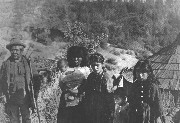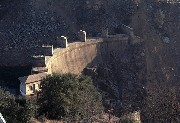History
Earliest Inhabitants
Evidence of human habitation within the New Melones project has been estimated to be 9,600 years old. Archaeological excavations and studies conducted in the early 1970's provided abundant evidence of these early inhabitants. The oak woodlands of the Upper Sonoran Life Zone provided conditions and resources favorable to year-round occupancy. Evidence collected and reported include stone hand tools such as hammer stones, scrappers and cutting tools, primitive spear points, and early spear throwing devices known as atlatl's.
Me-wuk means People
 For hundreds of years prior to the arrival of non-Indian missionaries, miners or early settlers, the people of the region were who we know today as Me-Wuk (or Mi-Wok) Indians. From a liberal estimate by early explorers, 9,000 Me-Wuk inhabited the central valley and Sierra Nevada Mountains. The Me-Wuk were believed to be the most populous of the California Indian groups, but by the 1910 census, only 670 surviving Me-Wuk Indians were recorded and of those, only half were full blooded. Divided into three groups by dialect and geography, Northern, Central and Southern, the Central Sierra Me-Wuk inhabited the New Melones Lake project area.
For hundreds of years prior to the arrival of non-Indian missionaries, miners or early settlers, the people of the region were who we know today as Me-Wuk (or Mi-Wok) Indians. From a liberal estimate by early explorers, 9,000 Me-Wuk inhabited the central valley and Sierra Nevada Mountains. The Me-Wuk were believed to be the most populous of the California Indian groups, but by the 1910 census, only 670 surviving Me-Wuk Indians were recorded and of those, only half were full blooded. Divided into three groups by dialect and geography, Northern, Central and Southern, the Central Sierra Me-Wuk inhabited the New Melones Lake project area.
Erroneously described as hunter-gatherers, the Me-Wuk practiced sophisticated and complex harvesting, management and cultivation techniques. They protected, encouraged and discouraged different resources, habitats, and plant and animal products through precise practices at carefully developed frequencies and intensities. Such practices included managed burning, digging, thinning, pruning, coppicing, harrowing, sowing, weeding, transplanting and selective harvesting. The landscape that the earliest non Indian arrivals to California encountered was not wild and untamed but actually the product of centuries of managed and manipulated environments.
Project Development
 In
the late 1890's during the Gold Rush, settlers began to divert water from the rivers to various areas throughout the foothills. Later in the decade, utilities began harnessing the rivers for hydroelectric power which was exported out of the basin. The U.S. Congress passed the Reclamation Act of 1902 which created the Reclamation Service, now the Bureau of Reclamation. Around the same time, local irrigation districts were created in the foothills. Two of these, the Oakdale and South San Joaquin Irrigation Districts constructed the 211 foot (64 m) high old Melones Dam in 1926 to provide water for agriculture. This original reservoir stored 112,500 acre-feet
of water.
In
the late 1890's during the Gold Rush, settlers began to divert water from the rivers to various areas throughout the foothills. Later in the decade, utilities began harnessing the rivers for hydroelectric power which was exported out of the basin. The U.S. Congress passed the Reclamation Act of 1902 which created the Reclamation Service, now the Bureau of Reclamation. Around the same time, local irrigation districts were created in the foothills. Two of these, the Oakdale and South San Joaquin Irrigation Districts constructed the 211 foot (64 m) high old Melones Dam in 1926 to provide water for agriculture. This original reservoir stored 112,500 acre-feet
of water.
In 1944, Congress authorized the construction of the New Melones Dam to prevent flood damage caused by rain and snowmelt to the 35,000 acres (14,164 ha) of downstream agricultural land and the communities of Oakdale, Riverbank, and Ripon as well as others further downstream. Congress modified this authorization in the 1962 Flood Control Act to include irrigation, power, wildlife and fishery enhancement, recreation, and water quality as reasons for construction.
The U.S. Army Corps of Engineers began construction in 1966. Approval for and construction of the reservoir was not without public controversy; however, the dam was completed in 1978, and the spillway and powerhouse were completed in 1979. In this final year, the Corps transferred the project to Reclamation, which has since managed the reservoir and surrounding landscape. The reservoir is now a part of the Central Valley Project, created to provide water to arid areas in California, and to minimize downstream flooding.
View (Historical) New Melones Lake Area Resource Management Plan and
Environmental Impact Statement Public Draft

